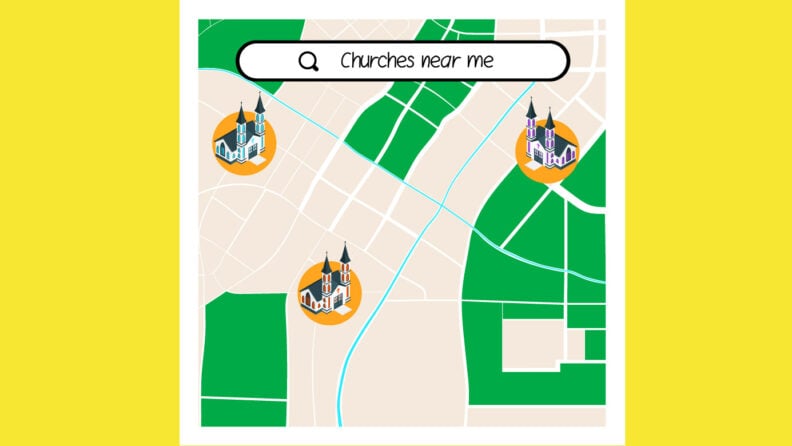Investment in SEO Can Pay Off: Churches can boost new members, online giving, and community awareness by enhancing their online presence.
Google My Business: Create a Google My Business listing and request positive reviews from members. You'll build online trust and rank higher.
Churches Near Me: Focus on local SEO by targeting the keyphrase "churches near me" to capture nearby audiences.
Account for Smartphones: Ensure your website is mobile-friendly to accommodate increasing mobile traffic.
You’ve seen it before, a church that has grown its online presence, and as a result, they’re seeing its congregation grow over time. You’ve tried to jazz up your website and make it more visually appealing, but it doesn’t seem to be helping. The reality is, that your site design may be fine, but you are missing out on one important piece of the puzzle. Someone mentions SEO for churches but you aren’t quite sure what it means or how to pull it off.
If you struggle to get your church website to appear in search results, the problem might not be what you think it is. (New to building websites? Choose the best church website building software tool for your church, then learn the six steps of website development.)
Today's focus? Learn the fundamentals of SEO (search engine optimization).
I’ll show you how to attract more traffic to your website from search engines - which can lead to getting noticed in your local community and more new visitors through the doors.
What Is Church SEO And Why Does It Matter?
Let’s start by understanding what website SEO means. It stands for Search Engine Optimization. It sounds scary, but it doesn’t have to be.
Location matters for churches. Ideally, your church is listed near the top of the search results when someone in your town or neighborhood searches Google for “churches near me”. To that end: there are four key pillars of SEO to keep in mind.
We will work through them sequentially here.
- Local SEO: optimizing a church’s online presence to improve visibility in local search results, increasing the likelihood of being found in searches within their area
- On-page SEO: improving individual web pages to rank higher and earn more relevant traffic
- Technical SEO: updating the backend structure of a website to ensure it meets technical requirements for search engines
- Off-page SEO: actions taken outside of your website to improve its authority in the eyes of search engines
Local Church Doubles Traffic After Implementing SEO Best Practices
Luke Schumacher designs websites for pastors and churches that want to increase their online footprint. Recently, he helped a client improve their website with a fresh design and (more importantly) implemented SEO best practices. Since then, the church reports website traffic has doubled.
They have new issues to resolve now - the good kind:
1. Running out of parking: More new guests come every Sunday, and they’re returning. Parking is getting tight!
2. Overflowing services: They are requesting people attend their other services.
3. Not enough t-shirts: They ran out of dry shirts and towels on a baptism Sunday when 107 people decided to get baptized. (Praise God!)

Local SEO Essentials For Churches
The best SEO will be focused on generating local traffic to your site. Don’t worry; a lack of technical knowledge doesn’t mean you can’t be a success. Start small and build from there. (Isn’t there a verse in Zechariah about not despising small beginnings?)
1. Harness the Power of Local
Here’s the good news: you don’t need to be the top-ranking church in the entire country. You just need to focus on showing up locally when people search “churches near me” in your area. A church blog about local events or issues and share stories of community outreach and involvement. These actions will show that your church is a relevant authority on the events in your local area.
2. Claim and Optimize Your Google My Business Listing
Get found more easily with a Google business profile. If you don’t have a listing with Google, creating one is straightforward! Once you’ve created and verified the account, populate your profile with your church website (send folks to your church 'about' page), service times, address, and phone number. Add photos of your building, service, and congregation. And you’re good to go!

3. Leverage Reviews and Testimonials
Often, before making a significant purchase, I first read reviews from others who have tried it. First-time visitors to churches often approach their visit the same way. Local reviews build trust with people and also increase your chances of showing up early on the search engine results page (SERP).
Ask your congregation to do a quick review of the church online. They can do this through Google, Facebook, and YELP. Those positive reviews can go a long way towards creating a great impression with potential visitors. (Don’t worry if there are some negative reviews mixed in. Respond to them gently, with love and understanding.)
Urban Church Uses SEO to Increase New Members, Giving, and Streaming
Knott Avenue Christian Church in Anaheim, California saw an average of 1,250 visitors per month to their website from search engines alone, with over 50% of those walking through the door as first-time visitors. HOW? They used a combination of SEO strategies:
1. Local Search Optimization: They optimized for search terms like "churches in Anaheim" and created listings on local review platforms such as CitySearch and Yellow Pages.
2. Utilization of Social Media: They expanded their online presence by actively using social media to engage with their community and promote church activities.
3. Content Delivery: The church began podcasting sermons and messages and creating an iPhone app, allowing members and potential visitors to easily access its content.
4. Local Listings: KACC set up listings on local review sites, Internet Yellow Pages, and church directories to enhance visibility in local searches.
Knott Avenue’s approach to SEO directly contributed to more attendees at church services, new members joining, and an increase in donations and engagement with their online broadcasts
4. Build Backlinks through Local Directories
A backlink is when other websites link to yours. Google likes to see them because it means that other websites see your site as an authority on your subject matter. These don’t usually happen by accident and will sometimes require a bit of effort on your part, but link-building does pay off.
You can increase your backlinks through:
- Community partnerships: participate in local events where your church may be mentioned in their promotions.
- Content creation and sharing: produce relevant content that will be shared from other sources.
- Guest posting on other websites and blogs: write articles for online publications or be a guest on a podcast. These contributions often include author bios with links back to the church's website.
- Online directories: include the church in local business and religious directories.
5. Optimize Your Homepage for Local Keywords
Make it clear who your target audience is with location-specific keywords, phrases, and headings. This will optimize your results with search engines. Use phrases like "church in [City Name]" or "[Denomination] church near me." If you have multiple campuses, create individual landing pages for each location.
6. Post Event Updates
Help your members stay current with the upcoming events at your church. Consider including events from other local organizations that may apply to the congregation. Consider featuring church leaders (with their bios) in various online event postings. Your events page is a good place also to encourage folks to sign up for your email list to stay up to date with the events and happenings of the church.
Develop a strong email marketing strategy to keep your congregation connected and engaged with the church and its activities.
7. Use Tools/Plugins to Help Optimize Your Content
There are countless tools and plugins available to help improve your content and optimize it for search engines. I know this is where things can seem a little bewildering, but stick with me:
- YoastSEO: A free WordPress plugin that helps you optimize your content for SEO performance, targeted to your specific audience. It’s widely used and great for beginners.
- RankMath: Known for its extensive free features, RankMath provides real-time content optimization suggestions, advanced snippet previews, and integration with Google Search Console.
- All in One SEO Pack (AIOSEO): Provides SEO services for beginners that are also customizable as your knowledge grows. It is free to start, but there are costs for additional features.
- Google XMP Sitemaps: Get your site indexed by search engines. This free plugin for WordPress automatically generates a sitemap for crawlers to access your site.
8. Encourage Social Media Engagement
Share posts, events, and other news to your social media platforms. This creates natural backlinks to your site and will boost visibility. Social media —love it or hate it —will be sticking around for a while. (Learn how to integrate a well-rounded social media marketing strategy to enhance your church presence online. )
ReachRight Studios is a Texas-based agency that helps churches get found online. I love how their heart for Jesus informs and infuses their attitude and approach to church SEO. Listen into this recent podcast episode:
Secondary SEO Strategies
Now that you have Local SEO under your belt, start expanding your knowledge with these strategies. Take your SEO to the next level and learn how to make your website more visible and attract more traffic.
9. Optimize for Mobile
Website traffic on mobile devices is continuing to increase, so make sure your website is mobile-friendly. Use a responsive design that adapts to different screen sizes. Optimizing for mobile is just one consideration when designing your new church website. We have created a shortlist of our favorite church website designs and why we like them.
Mid-Size Church Increase Visitors by 40%
Initially, Cypress Meadows Community Church's website ranked poorly. After implementing a focused SEO strategy—including keyword research, optimizing the site for local search terms, and creating listings on Google Maps and other directories—the church saw its search rankings improve dramatically.
Since implementing a robust SEO strategy, we have 225 top 10 search rankings, far surpassing our wildest expectations. Every Sunday we have new visitors to our services and many of them tell us they found our church through search engines.
Chuck Deitch, Cypress Meadows director of communications
These strategies translated into a 40% increase in unique visitors. The church noted an influx of new visitors each Sunday, with many reporting that they found the church through online searches, contributing to overall membership growth.
10. Improve Website Speed
An average adult’s attention span is about 8.25 seconds long. This means, that if I visit a website it doesn’t load quickly, then I’m gone. Do all that you can to improve the speed of your site to improve user experience. Having a fast site also improves SEO by allowing search engines to crawl more efficiently. You can do this by
- Compressing and resizing large images.
- Regularly clean up post revisions and spam comments.
- Upgrade hosting if necessary.
- Audit and eliminate unused plugins to streamline performance.
11. Secure Your Website with HTTPS
HTTPS stands for Hypertext Transfer Protocol Secure and assures visitors that the data exchange on your website is encrypted and secure. This builds the credibility of your site and will make your users more confident in their interactions with you. From an SEO perspective, Google considers HTTPS a ranking factor, meaning that secure sites may rank higher in search results compared to their HTTP counterparts. To do this, you will need an SSL certificate. This is often included by your web host, but it’s good to know about it to be sure that you have it on your site.
12. Regularly Publish Blog Posts
Update and post blog articles to tell the search engines that you are active on your site. Each blog post adds a new page to your site, leading to more indexed pages, and increasing your chances of showing up in a keyword search. Publish high-quality content around sermons and integrate your slides into your post. Share upcoming events, and local news to attract more organic traffic.
Christian School Fills Their Waiting List and Increases Enrollment
Bayshore Christian School in Tampa, FL had an uphill battle in their quest to improve their online reputation. Past technical problems resulted in incorrect negative reviews that penalized their rankings. Bayshore implemented a comprehensive SEO strategy, which grew their website traffic by 154%, increased their student applications by 133%. Their enrolment is maxed, requiring a waiting list.
1. Reputation Management: They focused on improving their online reputation by encouraging parents to leave positive reviews, and countering previous negative feedback.
2. SEO Audit and Keyword Research: They partnered with OurChurch.Com to conduct an SEO audit, identify relevant keywords, and optimize their website for local searches related to Christian and private schools in Tampa.
3. Content Creation: The school created helpful and informative blog content to establish authority with search engines and engage prospective parents seeking quality education.
As a result, Bayshore saw dramatic improvements. Organic search traffic grew by over 154%, leading to a fully enrolled school with a waiting list, a 47% increase in inquiries, and a 133% rise in applications.
There are so many ways to improve your SEO strategies. Whether you want to spend a lot or a little bit of time, ReachRight has many resources to help your church reach more people online through digital marketing.
Final Thoughts
Building a church website is a daunting task. Take it one step at a time and remember that your website will benefit from as much or as little time as you can invest to implement these church SEO strategies. As you follow the steps in this article, you’ll see your church website grow to a new level.
Join The Lead Pastor Newsletter List:
Stay inspired and informed with church management tips, growth strategies, and more. Join our newsletter for pastors and get practical tips, resources, and insights delivered right to your inbox.




